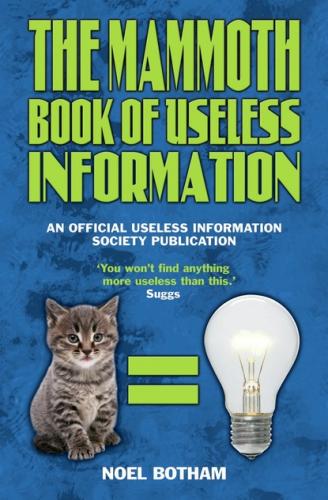As always to my wife, Lesley Lewis, with love
CONTENTS
Title Page
Dedication
1. INVENTIONS
2. THE WORLD AND ITS PEOPLE
3. NUMBERS
4. ARTS AND ENTERTAINMENT
5. THE THINGS PEOPLE SAY
6. COFFEE
7. SUPERLATIVES
8. THE ROMANS
9. STATISTICS
10. THE UNIVERSE
11. HISTORY
12. SAYINGS AND OMENS
13. SCIENCE AND NATURE
14. THE WIT AND WISDOM OF OSCAR WILDE
15. RELIGION
16. ALCOHOL
17. ASSASSINATED PRESIDENTS
18. ADVERTISING
19. SPORTS AND GAMES
20. LONDON
21. FIRSTS
22. THE UNDERGROUND
23. ABOUT THE SEXES
24. WAYS TO GO
25. LANGUAGE AND LITERATURE
26. THE BEATLES
27. FOOD AND DRINK
28. CRIME AND CRIMINALS
29. DOCTORS’ NOTES
30. MISCELLANEOUS
31. LAST WORDS
Copyright
• Benjamin Franklin invented swim fins.
• The abacus was invented in Egypt in 2000 BC.
• The Greek mathematician Archimedes invented the screw.
• The parachute was invented 120 years before the airplane. It was intended to save people who had to jump from burning buildings.
• The first pull-top can was invented by Ermal Cleon Fraze in 1959, after he had to resort to using his car bumper to open a can of drink.
• Kleenex tissues were originally invented to remove make-up. Maybe that’s why they’re still called ‘facial tissues’.
• Roulette was invented by Blaise Pascal, a French mathematician and scientist.
• In 1916, Jones Wister of Philadelphia, Pennsylvania, invented a rifle for shooting around corners. It had a curved barrel and periscopic sights.
• At the turn of the 19th century, most light bulbs were hand-blown, and the cost of one was equivalent to half a day’s pay for the average US worker.
• The first brassiere was invented in 1913 by teenage debutante Mary Phelps Jacob.
• The same man who led the attack on the Alamo, Mexican military general Antonio Lopez de Santa Anna, is also credited with the invention of chewing gum.
• The guillotine was originally called a louisette, after Antoine Louis, the French surgeon who invented it. It became known as the guillotine after Joseph Ignace Guillotin, the French physician who advocated it as a more merciful means of execution than the noose or axe.
• Benjamin Franklin invented the rocking chair.
• The modern zipper, the Talon Slide Fastener, was invented in 1913 but didn’t catch on until after World War I. The first dresses incorporating the zipper appeared in the 1930s.
• Western Electric invented the loudspeaker, which was initially called a ‘loud-speaking telephone’.
• The first VCR, made in 1956, was the size of a piano.
• The Chinese invented eyeglasses. Marco Polo reported seeing many pairs worn by the Chinese as early as 1275, 500 years before lens grinding became an art in the West.
• The first commercial vacuum cleaner was so large it was mounted on a wagon. People threw parties in their homes so guests could watch the new device do its job.
• It has been determined that less than one patented invention in a hundred makes any money for the inventor.
• The rickshaw was invented by the Reverend Jonathan Scobie, an American Baptist minister living in Yokohama, Japan, who built the first model in 1869 in order to transport his wife, who was an invalid. Today it remains a common mode of transportation in the Orient.
• The Ancient Romans invented the arch.
• The shoestring was invented in England in 1790. Prior to this time, all shoes were fastened with buckles.
• The state of Maine was once known as the ‘earmuff capital of the world’, as earmuffs were invented there by Chester Greenwood in 1873.
• The man who invented shorthand, John Gregg, was deaf.
• Because he felt such an important tool should be public property, English chemist John Walker never patented his invention – matches.
• In 1896, Herman Hollerith founded the Tabulating Machine Company. Twenty-eight years later, in 1924 and after several take-overs, the company became known as International Business Machines (IBM).
• The first mobile car phones were located in the car’s boot, taking up nearly half of the space.
• The Nobel Prize resulted from a late change in the will of Alfred Nobel, who did not want to be remembered after his death as a propagator of violence – he invented dynamite.
• Sylvan N. Goldman of Humpty Dumpty Stores and Standard Food Markets developed the shopping trolley so that people could buy more in a single visit to the grocery store. He unveiled his creation in Oklahoma City on 4 June 1937.
• The City and South London Railway opened the world’s first deep-level electric railway on 18 December 1890, running from King William Street in the City of London under the River Thames to Stockwell.
• The safety pin was patented in 1849 by Walter Hunt. He sold the patent rights for $400.
• The windmill originated in Iran in AD 644 and was used to grind grain.
• In 1832, the Scottish surgeon Neil Arnott devised waterbeds as a way of improving patients’ comfort.
• American Jim Bristoe invented a 30ft-long (9.1m), 2-ton (2.03-tonne) pumpkin cannon that could fire pumpkins up to 5 miles (8 km) at a time.
• Alexander Graham Bell applied for a patent for the telephone three days before he had got it to work. Had Bell waited until he had a working model, Elisha Gray, who filed a patent application the same day, would have been awarded the patent. But the telephone system we use is technically more like that described in Gray’s patent.
